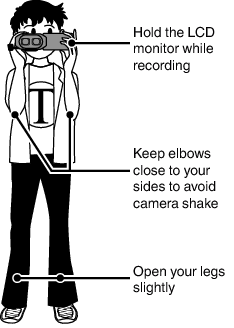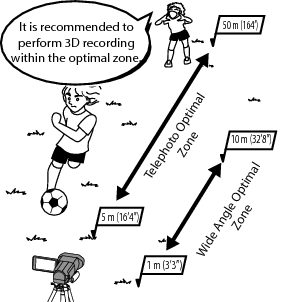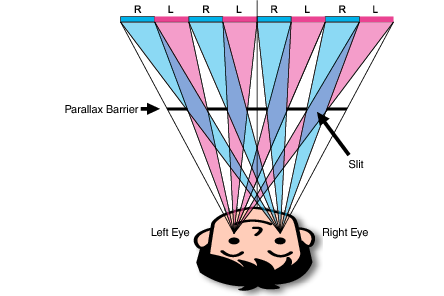Getting Started |
Precautions on Recording and Playing Back 3D Images |
3D images can be recorded and played back on this unit. You can enjoy realistic and powerful 3D images recorded on this unit by playing back on a 3D compatible TV. Before use, please read the following precautions to ensure safe and comfortable viewing of the 3D images.
Recording 3D Images
This unit makes use of the misalignment between the images that enter the left and right eyes to create the 3D effect during 3D recording. As the images that enter the left and right eyes are different, fatigue may be experienced. In addition, depending on the content of the video, an illusion of movement may be experienced and result in motion sickness. Take note of the following when recording 3D images.
Basic Way to Hold a Camcorder During 3D Recording
(Recording Stable Images)

Shooting Distance During 3D Recording
(Achieving Comfortable 3D Images)

Memo
- Make sure that you have stable footing during recording.
- Do not swing the camera horizontally or vertically during recording.
- If the subject is not recorded within the recommended shooting distance, 3D effect may be weak.
- When recording night scenes or landscapes, 3D effect of some subjects may be weak.
- For subjects that appear at the side of the screen, 3D effect may be weak.
- Operate slowly when using the zoom.
- If the image is zoomed in too much, 3D effect may be weak.
- It is recommended to make use of a tripod.
* If you do not take note of the above points during 3D recording, the recorded scenes may be played back in stop-motion during playback.
3D Display on the LCD Monitor
The LCD monitor supports 3D images during both recording and playback. Press the “3D/2D” button on the touch screen to change the display on the LCD monitor between 3D and 2D.
When using the 3D recording mode, the image will be recorded in 3D even if the display on the LCD monitor is set to 2D.
3D effect appears stronger when viewed at approximately 30 cm (11-3/4”) from the front.
3D effect may be weak if viewed from an angle other than the front.
The LCD monitor appears darker when 3D images are displayed. Change the display to 2D when it is difficult to see, such as when using this unit outdoors.
Caution
- Recording and viewing of the 3D images is not recommended for people with medical history of photosensitivity, heart diseases, feel sick, suffer from lack of sleep, suffer from fatigue, or are drunk.
- Do not shoot a subject from a distance shorter than the minimum shooting distance.
- Be careful not to shake the camera during recording.
- If you have vision problems such as short-sightedness, long-sightedness, varying vision in the left and right eyes, or astigmatism, it is recommended to correct your vision by wearing glasses, etc.
Stop recording or viewing of the 3D images if you see double images. - Stop recording or viewing of the 3D images if you experience fatigue or discomfort.
- If you experience fatigue or discomfort while recording or viewing of the 3D images on the LCD monitor, set the display to 2D.
- Rest well after recording or viewing of the 3D images.
- Take a break every 30 to 60 minutes when recording or viewing of the 3D images.
- Keep a distance of at least 3 times the effective height of the screen when viewing of the 3D images on a 3D compatible TV.
- Recording and viewing of the 3D images is only recommended for ages 5 to 6 and above.
Medical conditions may worsen.
The 3D effect may become stronger and result in fatigue or discomfort.
The minimum shooting distance of this camera is 80 cm (31-1/2”) (using wide angle).
Excessive shaking while riding in a vehicle or during walking may result in fatigue or discomfort.
To perform recording while moving the camera, keep the speed slow and steady.
Keep the camera in a horizontal position, as much as possible, during recording.
3D images may appear differently for different people. Correct your vision appropriately before viewing the 3D images.
Continual recording or viewing of the 3D images may result in health problems.
Take an adequate rest.
Recording or viewing of the 3D images in an environment where shaking of the monitor is expected, such as while riding in a vehicle or during walking, may result in fatigue or discomfort.
Continual recording and viewing of the 3D images may result in health problems.
After recording or viewing of the 3D images, check that you do not experience fatigue or discomfort before driving, etc.
Long periods of recording or viewing may cause visual fatigue.
Viewing of the 3D images from a distance shorter than the recommended distance may cause visual fatigue.
| TV Size | Recommended Distance |
|---|---|
|
54” |
Approx. 2.0 m (6’6-3/4”) |
|
50” |
Approx. 1.9 m (6’2-3/4”) |
|
46” |
Approx. 1.7 m (5’6-7/8”) |
|
42” |
Approx. 1.6 m (5’3”) |
Guardians should pay close attention to children as health problems may result if fatigue and discomfort are not noticed immediately.
3D Effect Mechanism

3D images on the LCD monitor of this unit are displayed using the parallax barrier system. Placed in front of an image source, a parallax barrier consists of a series of slits arranged alternately for the left and right eyes, allowing each eye to see a different image when viewing from a distance, thus creating the 3D effect. As such, 3D effect may appear weak depending on the angle of viewing.
